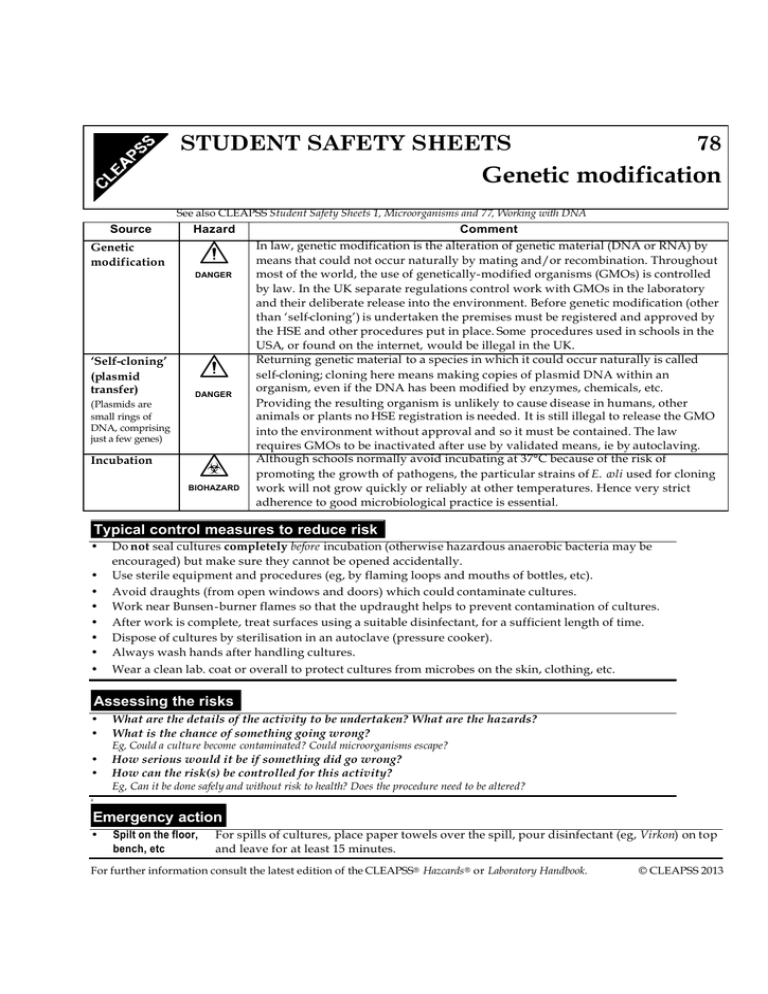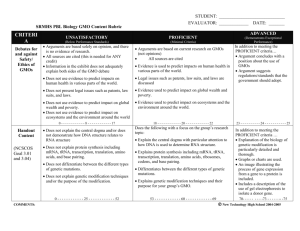! Genetic modification STUDENT SAFETY SHEETS
advertisement

STUDENT SAFETY SHEETS 78 Genetic modification See also CLEAPSS Student Safety Sheets 1, Microorganisms and 77, Working with DNA Source Hazard Genetic modification ! DANGER ‘Self-cloning’ (plasmid transfer) (Plasmids are small rings of DNA, comprising just a few genes) ! DANGER Incubation b BIOHAZARD Comment In law, genetic modification is the alteration of genetic material (DNA or RNA) by means that could not occur naturally by mating and/or recombination. Throughout most of the world, the use of genetically-modified organisms (GMOs) is controlled by law. In the UK separate regulations control work with GMOs in the laboratory and their deliberate release into the environment. Before genetic modification (other than ‘self-cloning’) is undertaken the premises must be registered and approved by the HSE and other procedures put in place. Some procedures used in schools in the USA, or found on the internet, would be illegal in the UK. Returning genetic material to a species in which it could occur naturally is called self-cloning; cloning here means making copies of plasmid DNA within an organism, even if the DNA has been modified by enzymes, chemicals, etc. Providing the resulting organism is unlikely to cause disease in humans, other animals or plants no HSE registration is needed. It is still illegal to release the GMO into the environment without approval and so it must be contained. The law requires GMOs to be inactivated after use by validated means, ie by autoclaving. Although schools normally avoid incubating at 37°C because of the risk of promoting the growth of pathogens, the particular strains of E. coli used for cloning work will not grow quickly or reliably at other temperatures. Hence very strict adherence to good microbiological practice is essential. Typical control measures to reduce risk • • • • • • • Do not seal cultures completely before incubation (otherwise hazardous anaerobic bacteria may be encouraged) but make sure they cannot be opened accidentally. Use sterile equipment and procedures (eg, by flaming loops and mouths of bottles, etc). Avoid draughts (from open windows and doors) which could contaminate cultures. Work near Bunsen-burner flames so that the updraught helps to prevent contamination of cultures. After work is complete, treat surfaces using a suitable disinfectant, for a sufficient length of time. Dispose of cultures by sterilisation in an autoclave (pressure cooker). Always wash hands after handling cultures. • Wear a clean lab. coat or overall to protect cultures from microbes on the skin, clothing, etc. Assessing the risks • • What are the details of the activity to be undertaken? What are the hazards? What is the chance of something going wrong? • • How serious would it be if something did go wrong? How can the risk(s) be controlled for this activity? Eg, Could a culture become contaminated? Could microorganisms escape? Eg, Can it be done safely and without risk to health? Does the procedure need to be altered? 4 Emergency action • Spilt on the floor, bench, etc For spills of cultures, place paper towels over the spill, pour disinfectant (eg, Virkon) on top and leave for at least 15 minutes. For further information consult the latest edition of the CLEAPSS® Hazcards ® or Laboratory Handbook. © CLEAPSS 2013







